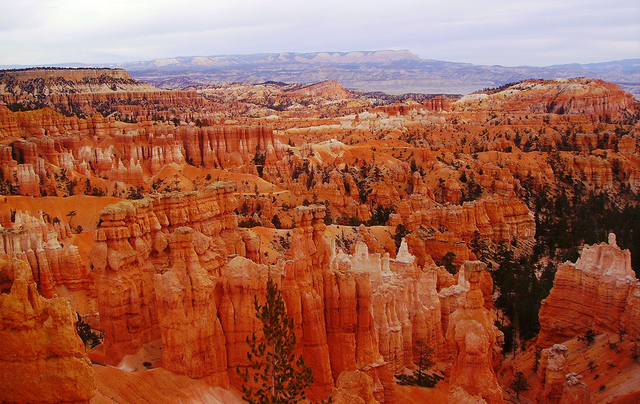Feast the eyes in cooler climes at Bryce Canyon
Bryce Canyon National Park, Utah, is such a feast for the eyes that more than a million people from around the world visit every year. Located on the eastern rim of the Paunsaugunt Plateau, the park features natural amphitheaters filled with a colorful landscape of spires, pinnacles and pillars called hoodoos.
Hoodoos are multi-colored limestone formations that are still works in progress. They are formed primarily by erosion during the 200 freeze-thaw cycles each year. On sunny winter afternoons, the snow and ice melt into the joints of the limestone. When the melt water refreezes, typically that very night, it expands. Repeated enough times, this will crack the rock and cause it to crumble over centuries.
Rain also helps to weather the formations. Runoff follows small gullies, gradually deepening them to leave narrow “fins” of rock between. Weak spots in the fins eventually become holes or windows. When the tops of these holes collapse, a free-standing column remains, which is a new hoodoo.
Because of the high elevation in the park, ranging from 6,620 feet at Yellow Creek to 9,115 feet at Rainbow Point, daily temperatures in summer very rarely reach even the 90s. Night temperatures dip into the 40s. These conditions make for ideal hiking, and there are plenty of choices depending on your physical abilities.
One of the favorite hikes in the park is the 1.3-mile Navajo Loop Trail. It’s moderately strenuous, but it takes you down among the hoodoos. This hike begins at Sunset Point and travels down into a slot canyon below the rim. For those with a bit more time and energy, I recommend the Fairyland Loop Trail, which travels for about 8 miles total and features stunning formations along the route, including China Wall and Tower Bridge.
If hiking isn’t your thing, just driving the 18-mile scenic drive is worth a visit here; there are 14 viewpoints where you can stop for a lingering look. The best way to enjoy the scenic drive is to proceed nonstop to the end at Rainbow Point, then stop at the viewpoints as you return. On your return, they’re all on the right side of the road.
Because there is little stray light in the park, on a clear, moonless night, visitors can see more than 7,000 stars. Astronomy programs take place through the fall, typically featuring a one-hour multimedia presentation followed by 90 minutes at the telescope stations. From now through September, the programs are scheduled Tuesday, Thursday and Saturday evenings. In July, they are set at 9 p.m. (There will be no program on July 25 because of the Geology Festival.) In August, they are set at 8:30 p.m. and in September, at 8 p.m. In October, they move to 7:30 p.m., Tuesday and Saturday only.
There are two campgrounds in the park, North and Sunset. Both offer restrooms, picnic tables and drinking water. North Campground has 13 RV sites available by reservation, and 86 RV and tent sites on a first-come, first-served basis. Sunset has 20 tent sites and one group site available by reservation; another 80 RV and tent sites are first-come, first-served. Visit recreation.gov.
There are many privately operated campgrounds in the immediate vicinity, including at Ruby’s Inn, just outside the park boundary. They also have cabins, teepees and an RV Park. Reservations are recommended; call 866-878-9373 or visit rubysinn.com. The Bryce Canyon Visitor Center is open in summer from 8 a.m. to 8 p.m. daily. Call 435-834-5322 or visit nps.gov/brca.
Directions
From Las Vegas, take Interstate 15 north 125 miles to Utah state Route 9 (exit 16-Hurricane/Zion National Park). Follow that for 57 miles through Zion, and turn left at Mt. Carmel Junction. Take U.S. Highway 89 north for 43 miles to a right onto Utah state Route 12. Follow that for 14 miles, and turn right on Utah state Route 63. Travel 3 miles to the park entrance.
Deborah Wall is the author of “Great Hikes, A Cerca Country Guide” and “Base Camp Las Vegas: Hiking the Southwestern States,” published by Stephens Press. She can be reached at deborabus@aol.com.






















